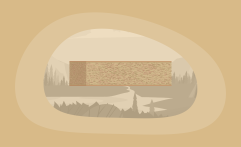10 Most Sustainable Recycled Nylon Clothing Brands: The Conscious Consumer’s Guide
Affiliate Disclosure
Hey fellow impactful ninja ?
You may have noticed that Impactful Ninja is all about providing helpful information to make a positive impact on the world and society. And that we love to link back to where we found all the information for each of our posts.
Most of these links are informational-based for you to check out their primary sources with one click.
But some of these links are so-called "affiliate links" to products that we recommend.
Why do we add these product links?
First and foremost, because we believe that they add value to you. For example, when we wrote a post about the environmental impact of long showers, we came across an EPA recommendation to use WaterSense showerheads. So we linked to where you can find them. Or, for many of our posts, we also link to our favorite books on that topic so that you can get a much more holistic overview than one single blog post could provide.
And when there is an affiliate program for these products, we sign up for it. For example, as Amazon Associates, we earn from qualifying purchases.
What do these affiliate links mean for you?
First, and most importantly, we still only recommend products that we believe add value for you.
When you buy something through one of our affiliate links, we may earn a small commission - but at no additional costs to you.
And when you buy something through a link that is not an affiliate link, we won’t receive any commission but we’ll still be happy to have helped you.
What do these affiliate links mean for us?
When we find products that we believe add value to you and the seller has an affiliate program, we sign up for it.
When you buy something through one of our affiliate links, we may earn a small commission (at no extra costs to you).
And at this point in time, all money is reinvested in sharing the most helpful content with you. This includes all operating costs for running this site and the content creation itself.
What does this mean for me personally?
You may have noticed by the way Impactful Ninja is operated that money is not the driving factor behind it. It is a passion project of mine and I love to share helpful information with you to make a positive impact on the world and society. However, it's a project in that I invest a lot of time and also quite some money.
Eventually, my dream is to one day turn this passion project into my full-time job and provide even more helpful information. But that's still a long time to go.
Stay impactful,
Amid growing concerns about the textile industry’s environmental impact, there is pressure to find greener clothes for your wardrobe. Recycled nylon is joining the “preferred materials” group as it bypasses polluting and resource-intensive nylon production. Unfortunately, fashion greenwashing makes it harder for you and all other consumers to figure out which hemp clothing brands offer the most eco-friendly clothes. So, we had to ask: Which are the most sustainable recycled nylon clothing brands?
The most sustainable recycled nylon clothing brands include Patagonia, Finisterre, and Mara Hoffman, which use low-impact materials, employ full traceability, and strive for textile circularity. In addition, Ecoalf and ASKET commit to reducing carbon footprints and plastic pollution.
Whether you’re searching for an outdoor jacket, a pair of stockings, or some swimwear to add to your wardrobe without negatively impacting the soil, the water, the animals, and other people, there is a brand for you. So, let’s keep reading to learn more about the most sustainable recycled nylon clothing brands and how they ensure sustainable, ethical practices.
Here’s How Sustainable Recycled Nylon Fabrics Generally Are
Recycled nylon fabrics are generally considered sustainable. Reusing nylon waste like fishing nets or carpets to make recycled nylon clothes reduces the pressure on fossil fuels—the raw materials for most virgin nylon. It leads to recycled polyester generally being a low-impact fabric, especially compared to conventional nylon. The Common Objective’s Made-By Environmental Benchmark for Fibres ranked mechanically recycled nylon Class A—the most sustainable category of fibers.
“Sustainable: The ability to be maintained at a certain rate or level | Avoidance of the depletion of natural resources in order to maintain an ecological balance”
Oxford Dictionary
To understand the sustainability of recycled nylon, we’ve assessed the life-cycle and each stage’s sustainability. This life-cycle assessment (LCA) is a method to evaluate the environmental impacts of products and materials. Here’s the quick summary of our LCA of recycled nylon!
What makes recycled nylon so sustainable: Recycled nylon fabrics re-circulate plastic waste that would otherwise take up space in landfills for centuries or get into marine environments, potentially harming animals and humans.
Additionally: Diverting discarded plastic-based materials back into the economy slows down the demand for land needed to store plastic waste, which could keep its form instead of breaking down for centuries.
Here’s How We Selected the Most Sustainable Recycled Nylon Clothing Brands
The brands on this list were chosen based on their commitment and actions to promote sustainable practices while reducing the environmental impacts of the textile industry.
They are transparent about their materials, processes, and workforce management within their supply chain.
Some brands focus their efforts on reducing waste and optimizing natural resources while others strive to reduce the carbon footprint of their clothes.
All of these brands share the commitment to reshape the textile industry toward a more sustainable and Earth-friendly sector.
These Are the 10 Most Sustainable Recycled Nylon Clothing Brands
Most Sustainable Recycled Nylon Clothing Brands
Overall, these recycled nylon clothing brands are sustainable. Yet, they take various approaches to reduce environmental impacts and uphold ethical standards. Let’s dive into each brand and find out more.
Patagonia: Everyday Wear for Those Who Care
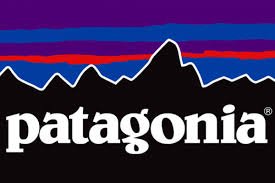
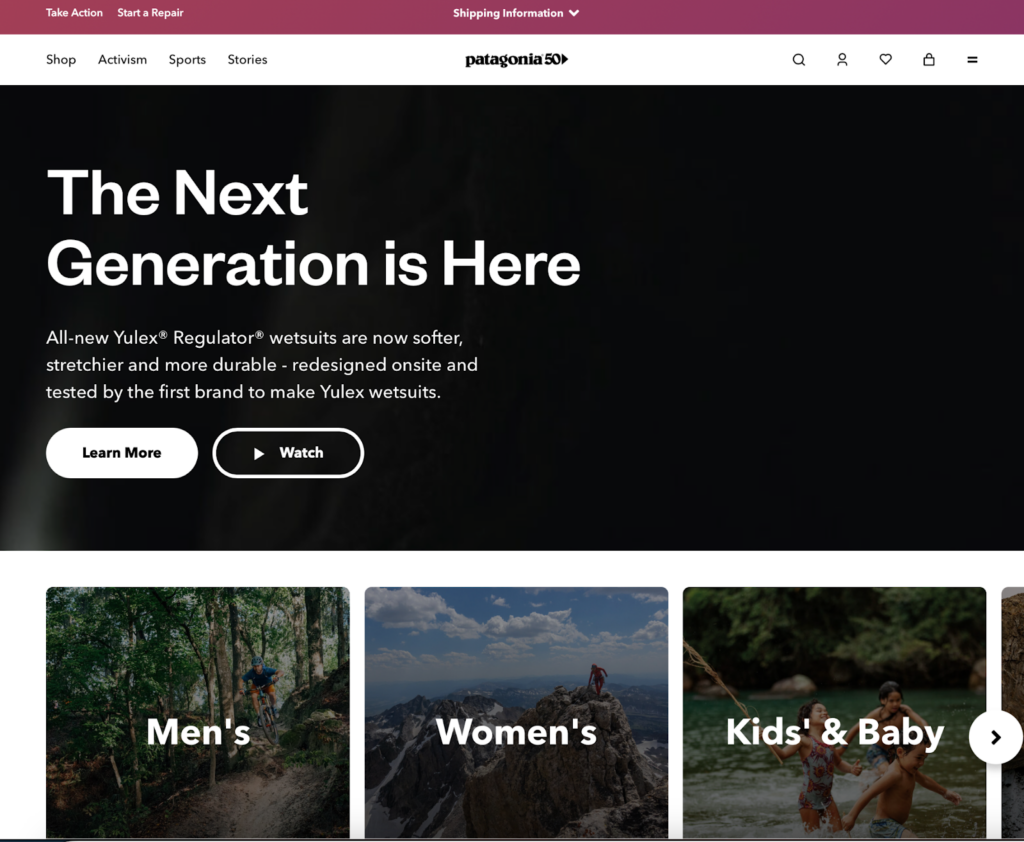
“Together, we can prioritize purpose over profit and protect this wondrous planet, our only home.”
Patagonia
🌎
How do they ensure their sustainability?
Patagonia puts sustainability at the center of their operation.
- They work to reduce, rather than simply offset, carbon emissions where it matters the most: in the supply chain and in material manufacturing. They reduce their carbon footprint by removing high-impact virgin fossil-based fibers from their collections, using “Environmental Profit and Loss” to guide their production decision, and helping their suppliers to cut emissions. For example, Patagonia’s fall 2023 collection was made up mostly of preferred materials (91% by fabric weight), including Regenerative Organic Certified fibers, hemp, man-made cellulose fibers, recycled cotton, and recycled polyester.
- On top of that, Patagonia’s Worn Wear Program encourages customers to repair and recycle their products, extending the textile lifecycle and reducing waste.
- Lastly, Patagonia is certified as a B Corporation and a Bluesign® brand.
🌐
How do they ensure their ethics?
Patagonia commits to fair trade practices. Through the partnership with Fair Trade USA, they currently produce 86% of their clothes in 20 Fair Trade Certified™ factories.
- Patagonia also pays a premium for every item produced in such factories, accumulating in a fund for workers to use in their chosen community projects, whether in healthcare or parent support or to withdraw as a cash bonus.
- Additionally, they have various social responsibility programs to prevent harm and create positive impacts on the lives of apparel workers in their supply chain. These include the Fair Labor Association, the Living Wage Program, the Migrant Workers Program, and the Responsible Purchasing Practices.
- Patagonia is also fully transparent about the locations of their facilities and suppliers.
🤝
Are they part of any giving-back programs?
Since 1985, Patagonia has pledged 1% of sales annually to environmental causes. They have awarded over $89 million in cash and kind donations to domestic and international grassroots environmental groups, making a difference in their local communities. In 2022, the founder of Patagonia gave away his family’s ownership of the company to the newly created Patagonia Purpose Trust and the not-for-profit organization Holdfast Collective, ensuring that all future profits from the company are used to fight the climate and extinction crisis.
🛍️
What is their product range?
- Best for: kidswear, menswear, womenswear
- Product range: shirts, pants, jackets, blazers, hoodies, sweatshirts, T-shirts, shorts, plus-size
- Price range: $$$
- Size range: XXS–XXXL
Mara Hoffman: Womenswear Brand Promoting Mindful Fashion Habits

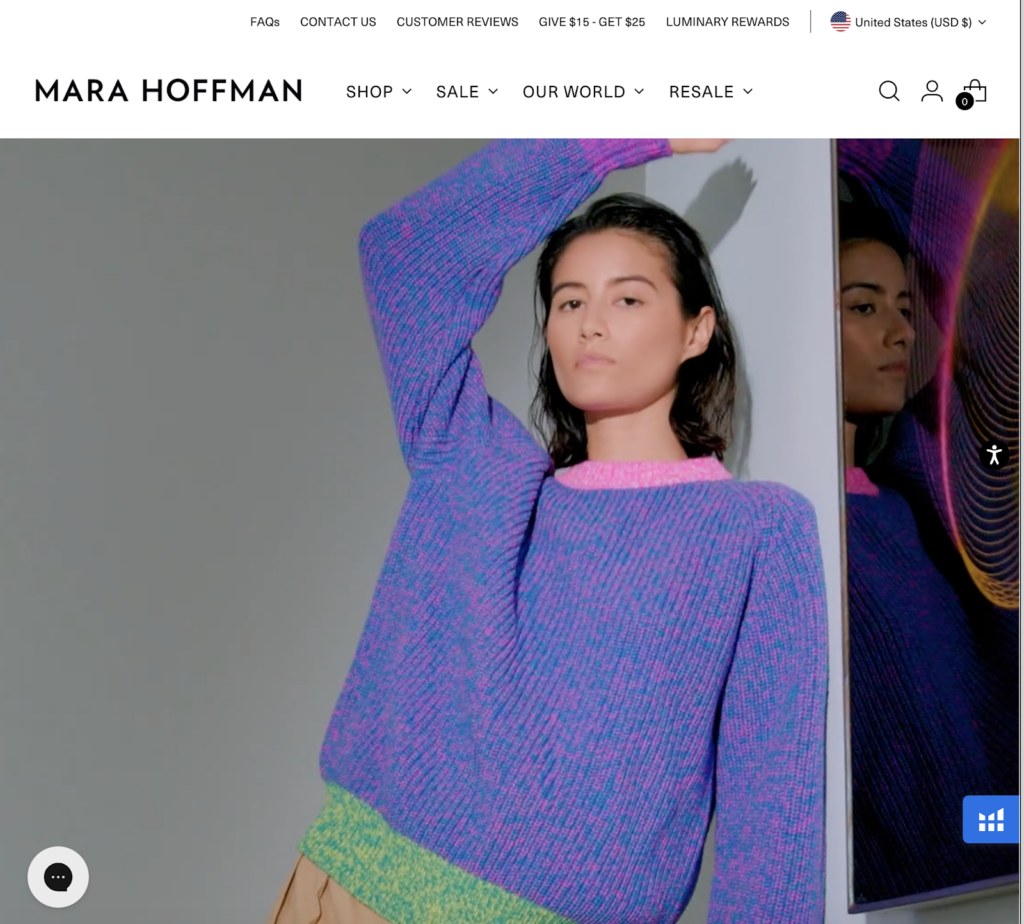
“As a team, we remain committed to reducing our footprint on the planet by extending the life of each garment, contributing to the regeneration of the environment, and advocating for the communities least responsible for, yet most impacted by, climate change.”
Mara Hoffman
🌎
How do they ensure their sustainability?
Mara Hoffman’s sustainability efforts focus on responsible materials, low-impact manufacturing practices, and mindful fashion habits.
- When sourcing for their designs, they prioritize natural, recycled, and organic materials over virgin synthetic fabrics while opting out of fur, leather, and feathers. Specifically, their modal fabrics are sourced from top-ranking man-made fiber producers on Canopy’s Hot Button Report, Lenzing and Birla Cellulose, while their lyocell fabrics are made by Lenzing and the circular fashion brand Circ.
- Additionally, their packaging is free from plastics and uses natural materials that can be easily recycled. Since 2019, they have transitioned into 100% recycled paper mailers for small shipments.
- Regarding the manufacturing stage, Mara Hoffman aims to minimize waste and energy usage wherever possible. For example, they choose digital printing to reduce fabric waste and water waste.
- Lastly, they encourage mindful fashion habits such as “Wear More, Wash Less“, repairing, and repurposing to keep garments lasting a long time while reducing the climate impact. They also have a platform, Full Circle Marketplace, where you can buy and sell pre-owned Mara Hoffman garments.
🌐
How do they ensure their ethics?
Mara Hoffman works with Fair Trade Certified™ products and factories to ensure workers receive premium work payment.
- Additionally, they regularly conduct in-person factory visits.
- They also support the growth of smaller factories with incentives like sponsoring website development and delivering training programs on transparent record-keeping.
- For transparency, they publish the list of the Tier 1 factories where the last stage of production happens.
🤝
Are they part of any giving-back programs?
As Mara Hoffman has shifted toward sustainability, they have increased contributions to and participation in social justice movements. They give back in various ways, including sponsoring, fundraising, and mentoring, in partnership with many organizations working toward social justice and sustainability. The list includes Black in Fashion Council, CanopyStyle, Equality Now, Woman March, and Sweet Freedom Farm.
🛍️
What is their product range?
- Best for: womenswear
- Product range: dresses, tops, blouses, pants, skirts, swimwear, jumpsuits, playsuits, bodysuits, plus-size
- Price range: $$$
- Size range: XS–XXXL
Finisterre: Ocean-Inspired Sustainable Outdoor Gear Made Ethically

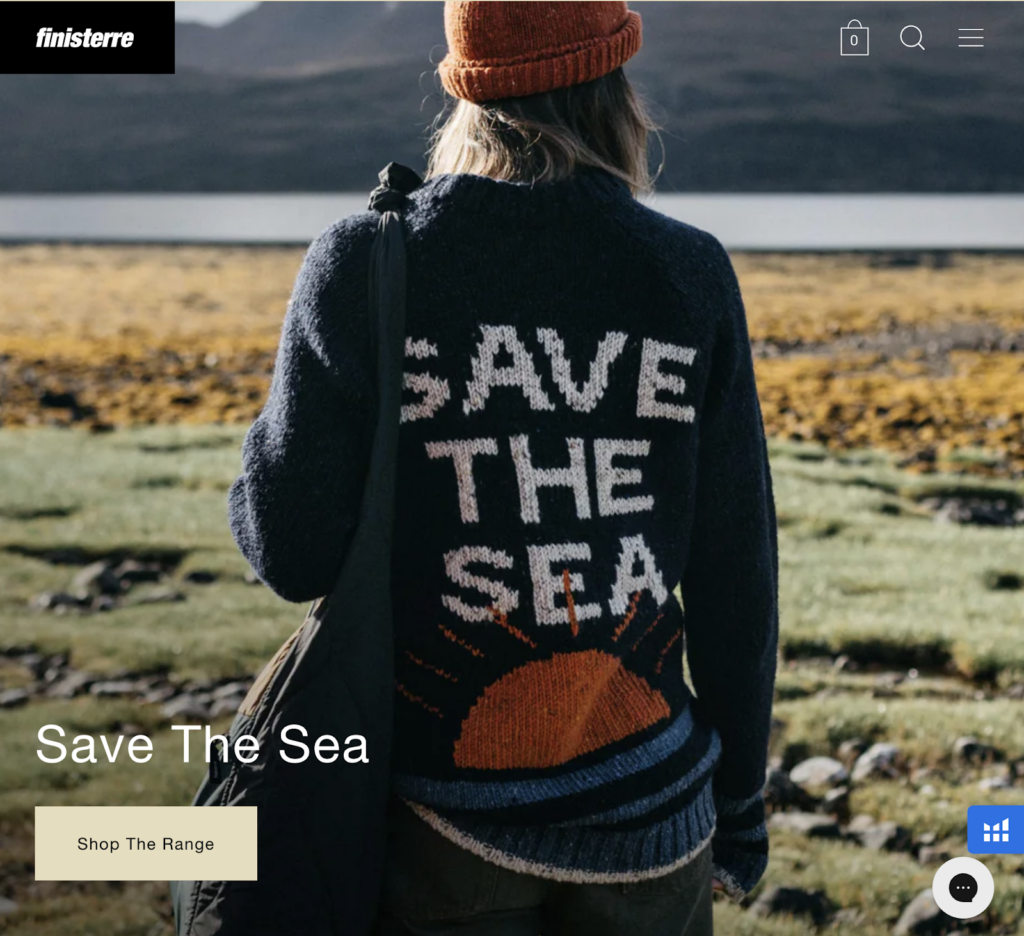
“Yet from our cliff top workshop, we stay true to our original design ethos of functionality and sustainability, remaining committed to product, environment and people.”
Tom Kay, Founder of Finisterre
🌎
How do they ensure their sustainability?
Finisterre places circular sourcing at the center of their sustainability commitment.
- They use renewable and recyclable textiles, as well as biodegradable natural fibers and finishes. At least 50% of their clothes are made using recycled fabrics. For example, in 2022, 87% of the synthetic polymer fabrics used in Finisterre clothes were made using recycled fabrics, including polyester recovered from post-consumer and post-industrial waste. They also use low-impact natural fibers, including GOTS-certified organic cotton, hemp, linen, and bamboo.
- In 2019, they replaced all plastic packaging with water-soluble, ocean-safe, and biodegradable “Leave No Trace” garment bags. Finisterre also strives to reduce textile waste by offering repair services and giving in-store credits for gear trades-in, which would be reconditioned for resale.
- On top of that, they implement various incentives to reduce their carbon footprint, including switching more of their stores and offices to renewable energy tariffs and transporting products using less carbon-intensive modes on land and sea.
- Last but not least, Finisterre is a B Corporation.
🌐
How do they ensure their ethics?
Finisterre is committed to full transparency in their supply chain, holding their partners to the high standards in their Code Of Conduct and their Anti-Slavery & Trafficking Policy.
- Additionally, they partner with Fair Working Conditions (FWC), enabling the mapping of their supply chain, the screening of suppliers, and targeted audits at high-risk locations. Their facilities are also listed on Open Supply Hub.
- Finisterre’s ethical values also extend to their dedication to saving the sea. For example, they provide a free resource to inspire ocean activism.
- Regarding animal rights, they source wool from non-mulesed sheep.
🤝
Are they part of any giving-back programs?
Finisterre provides financial support to various giving-back campaigns and programs through the Finisterre Foundation, championing ocean access for all. For example, Finisterre turned 2021’s Black Friday into Blue Friday, where they swapped discounts for donations, raising funds for the Wetsuit Project, which adapts wetsuits for children and adults with various disabilities to access the sea. In 2022, Blue Friday was used again to raise money supporting Level Water to provide specialist swimming lessons for children with disabilities. Other projects include The Seasuit Project, City Kids Surfing, Seasuit Donation, and Art Auctioning for Good.
🛍️
What is their product range?
- Best for: menswear, womenswear
- Product range: shirts, pants, tops, sweaters, dresses, hoodies, shorts, denim, swimwear, jackets, blazers, sweatshirts, T-shirts, baselayers, socks
- Price range: $$
- Size range: XS–XXL
Ecoalf: Committing to Recycling Waste and Cleaning the Environment

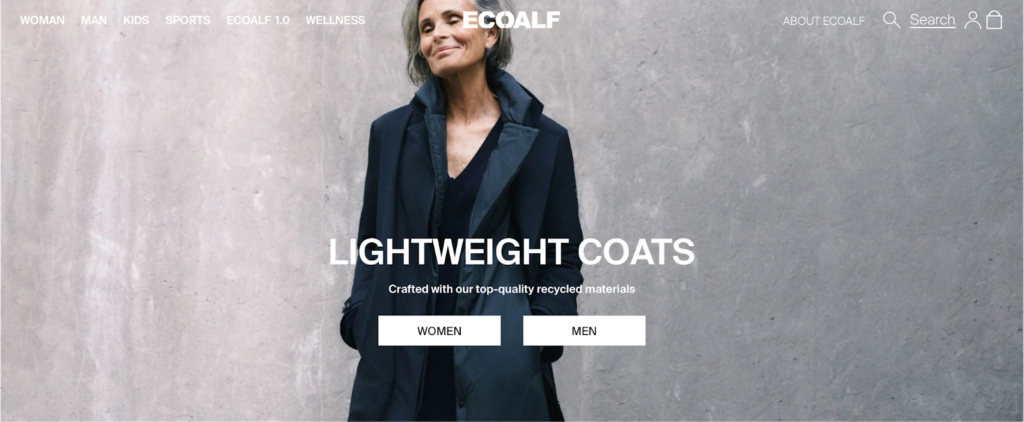
“I believe the time when fashion was just about looking good is over. More than ever it has to be about doing what is right and feeling good about it.”
Javier Goyeneche, founder of Ecoalf
🌎
How do they ensure their sustainability?
Ecoalf’s commitment to sustainability is evident in their innovative recycling practices.
- They minimize the use of natural resources by using mainly waste as raw materials, collecting and transforming discarded materials into recycled fabrics like recycled polyester, recycled nylon, recycled cotton, recycled wool, and recycled cashmere.
- In 2023, they launched their first 100% recycled cotton collection that can be recycled again to achieve circularity. Back further in 2021, 74% of the materials used by Ecoalf were recovered from waste, saving 1,377 tons of CO2.
- In combination with recycled fabrics, Ecoalf uses a small percentage of low-impact natural fabrics, such as linen and kapok. Ecoalf is also Bluesign® and B Corporation certified.
🌐
How do they ensure their ethics?
Ecoalf ensures their ethics by protecting their workers and the environment.
- In particular, they ensure there are safe and fair working conditions in their supply chain by mandating a Code of Conduct, an Equality Scheme, a Crime Prevention Handbook, a Disciplinary System, and a Bullying at Work Protocol.
- Additionally, they run many campaigns to raise awareness of the state of our ocean and earth-damaging consumerism habits.
🤝
Are they part of any giving-back programs?
Ecoalf actively participates in giving-back programs. The Ecoalf Foundation was founded to clean the oceans of marine waste with the help of the fishing industry while giving a second life to plastic waste through recycling and closing the loop. They achieve that with the “Upcycling the Oceans” projects. In 2021, Ecoalf donated 10% of all Because There’s No Planet B sales to the Ecoalf Foundation to expand the “Upcycling the Oceans” project beyond the Spanish border and into countries like Thailand, Greece, and France. The foundation also partners with Biotherm to set up the framework of “Limpia ríos, salva océanos”, a project supported by corporate volunteer days to collect waste and restore the environment. Additionally, Ecoalf’s employees volunteer in various environmental incentives.
🛍️
What is their product range?
- Best for: womenswear, menswear, kidswear
- Product range: shirts, pants, jackets, blazers, hoodies, sweatshirts, tops, blouses, knitwear, T-shirts, sneakers, accessories
- Price range: $$
- Size range: XS–XL
ASKET: Timeless Clothes Made Under Full Transparency and With Life-Cycle Responsibility
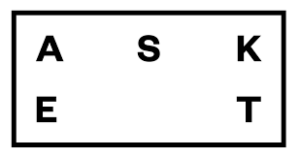

“Our mission is to end overconsumption and restore value to the clothing industry.”
Jakob Dworsky, founder of ASKET
🌎
How do they ensure their sustainability?
ASKET ensures sustainability by reducing waste and using less energy throughout the life-cycle of their garments.
- They tackle the textile waste problem with their Repair Program, which helps keep clothes last longer, and their Revival Program, which diverts used garments from landfills to be repaired, renewed, resold, or recycled. On top of that, they use various recycled fabrics, including GRS-certified recycled wool, recycled cotton, and recycled silk. ASKET also runs a Care Program, helping customers keep their garments fresh longer while using less energy, lowering the environmental impact of the usage stage.
- Additionally, ASKET’s collection includes eco-friendly materials such as organic cotton, linen, and TENCEL™ lyocell. And finally, in an effort to encourage customers to buy and waste less, they are fully transparent about the environmental impact of their clothes.
🌐
How do they ensure their ethics?
ASKET maintains ethics through fair labor practices, responsible sourcing, and a commitment to transparency in their supply chain. In 2022, their average traceability score across their entire collection was 96.0%.
🤝
Are they part of any giving-back programs?
ASKET is not known to be part of any giving-back programs.
🛍️
What is their product range?
- Best for: high-quality, essential, versatile wardrobe pieces
- Product range: tops, sweaters, pants, chinos, jackets, coats, socks, underwear
- Price range: $$$
- Size range: XS–XXL
Girlfriend Collective: Essential and Timeless Activewear Made Out of Recycled Materials

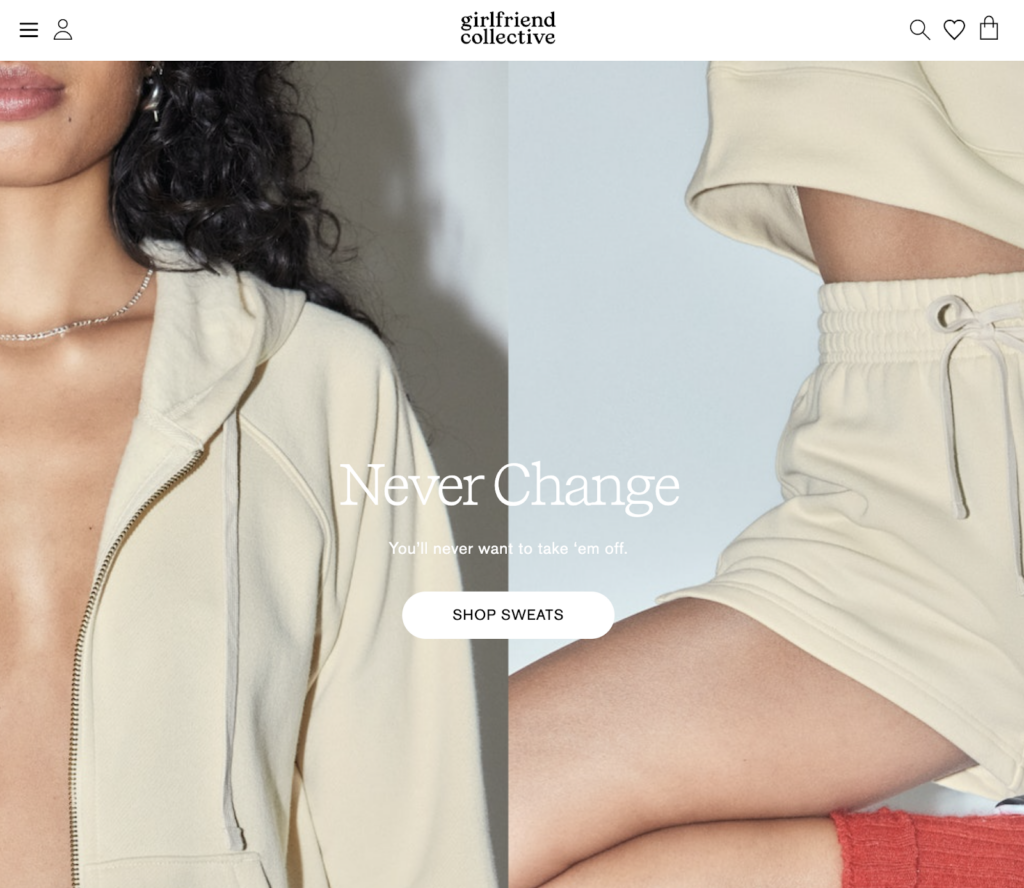
“We make everything locally in small batches to make sure we don’t have a negative impact on the environment.”
Girlfriend Collective
🌎
How do they ensure their sustainability?
Girlfriend Collective’s sustainability efforts start with using recycled and recyclable textile and packing materials.
- Their clothes are made from recycled materials such as post-consumer water bottles, fishing nets retrieved from the seas, fabric scraps, and other waste. On top of that, their packaging is 100% recycled and recyclable. After their clothes are dyed, all the wastewater is sent to a treatment plant 100 feet away. Treated water that meets safety standards is released into the waterway, while mud dye is donated to a pavement facility to be turned into paving stones.
- Additionally, they help prevent microfiber release with a branded microfiber filter. Their program “Recycle. Reuse. Regirlfriend.” collects old Girlfriend Collective compressive leggings and upcycles them into new pieces that can be worn again and again, reducing waste while moving toward a more circular fashion model.
- Lastly, Girlfriend Collective partners with EcoCart to provide a carbon-neutral option for all orders placed on their site to offset the carbon footprint of their products.
🌐
How do they ensure their ethics?
Girlfriend Collective’s facilities are fully certified by Social Accountability International – SA8000. An SA8000 certification guarantees safe working conditions, the right to unionize, and no forced or child labor. They also ensure all workers in their supply chain are paid fair wages and provided with free lunches and guided exercise breaks.
🤝
Are they part of any giving-back programs?
Girlfriend Collective is not known to be part of any giving-back programs.
🛍️
What is their product range?
- Best for: womenswear
- Product range: dresses, hoodies, sweatshirts, activewear, sportswear, maternitywear, tops, blouses, T-shirts, stockings, tights, shorts, lingerie, plus-size
- Price range: $$$
- Size range: XS–XL
Vitamin A: Swimwear and Beachwear Made Sustainably With Recycled Nylon


“We focus on the intersection of flawless fit, high quality, continuous innovation, and elegant designs… Every one of our pieces is designed by women, for women.”
Amahlia Stevens, founder of Vitamin A
🌎
How do they ensure their sustainability?
Vitamin A ensures their sustainability by sourcing recycled synthetic materials for their products and manufacturing them locally using low-impact technologies.
- They use recycled nylon in place of virgin nylon to create fabric blends for their bikinis, swimsuits, and beachwear lines, saving 77% water usage. The brand also incorporates sustainable natural fabrics and high-performing plant-based textiles into their products, including GOTS-certified organic cotton, linen, recycled cotton, and TENCEL™. All materials used by Vitamin A are certified to meet the global OEKO-TEX® STANDARD 100 for safe textiles. On top of that, the majority of their swimwear is crafted locally in Californian vertically integrated facilities (and the rest in the US), reducing the transporting carbon footprint.
- Regarding production, they use mostly digital printing, which requires less water and creates less fabric waste than traditional wet printing.
- Other measures used at their headquarters and warehouse to reduce their environmental footprint include all paper products made with 100% recycled post-consumer waste, no disposable plastic water bottles, a heat reclamation system, and working-from-home support to avoid unnecessary travel.
🌐
How do they ensure their ethics?
Vitamin A ensures their ethical and responsible production by keeping production locally in California, which has the strictest environmental laws in the nation. They also visit their factories regularly to ensure employees are being treated and paid fairly and that the working conditions are clean and safe.
🤝
Are they part of any giving-back programs?
Vitamin A is a proud member of 1% for the Planet. They give back to organizations that work to protect the oceans. Additionally, they host beach cleanups.
🛍️
What is their product range?
- Best for: womenswear
- Product range: swim tops, swim bottoms, beach tops, beach bottoms, one pieces, dresses, rompers, shirts, pants, overalls, hoodies, shorts, accessories
- Price range: $$
- Size range: XS–XXL
Swedish Stockings: Quality Stockings From Recycled Materials

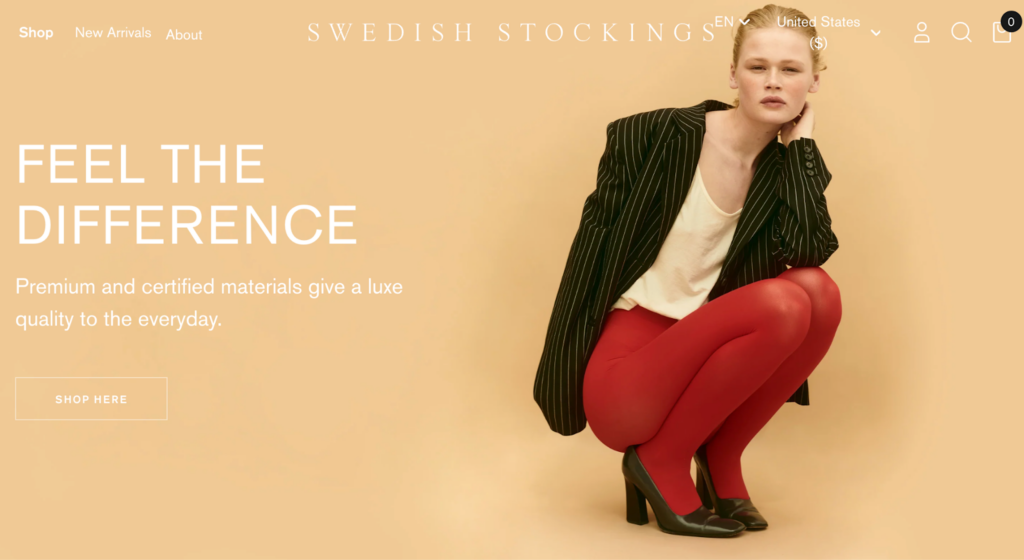
“If we can create a product that women can wear for a longer time, then we can also buy less.”
Linn Frisinger and Nadja Forsberg, Founders of Swedish Stockings
🌎
How do they ensure their sustainability?
Swedish Stockings promotes sustainability by opting for low-impact materials while minimizing waste by recycling their textile offcuts and collecting post-consumer synthetic stockings.
- Instead of sourcing conventional virgin fossil-based polyamide (nylon) for their tights, Swedish Stockings uses high-quality recycled nylon, specifically Aquafil‘s ECONYL®, Fulgar‘s Q-NOVA® and Q-CYCLE®, and Nilit’s SENSIL® Ecocare. They also use bio-based nylon and natural materials (GOTS-certified organic cotton, Responsible-Wool-Standard-certified organic wool, and cashmere).
- While they are not yet able to close their production loop by recycling old hosiery into new products themselves, Swedish Stockings still contributes to reducing textile waste by encouraging consumers to send in their used synthetic pantyhose for a 10% discount code of their products. The collected synthetic pantyhoses are turned into filler materials in tanks and tables. Additionally, Swedish Stockings uses FSC-certified packaging.
- Last but not least, they are transparent about the footprint of their products, disclosing the product journey along the supply chain, including the distance traveled and the cradle-to-gate impacts regarding water scarcity, global warming, eutrophication, and abiotic depletion.
🌐
How do they ensure their ethics?
Swedish Stockings has a Code of Conduct that covers the ILO’s Four Fundamental Freedoms principles.
- They also trace all of their supply chain.
- The final production stage happens in Italian factories with extremely high ethical, social, and environmental standards. They disclose all the supply partners in Italy, including any sustainability and quality certifications granted for such factories.
🤝
Are they part of any giving-back programs?
Swedish Stockings is not known to be part of any giving-back programs./what
🛍️
What is their product range?
- Best for: womenswear
- Product range: stockings, tights, socks, leggings, tops, bras
- Price range: $$$
- Size range: XS–XXL
Elle Evans: Swimwear Made to Order From Circular Regenerated Nylon


“I knew I wanted to structure my company differently, and starting from scratch meant that sustainability could be at the heart of every decision I made.”
Elle Evans, founder of Elle Evans
🌎
How do they ensure their sustainability?
Elle Evans prioritizes sustainability by reducing the carbon footprint throughout the life-cycle of their products, from sourcing to transporting and packaging.
- Firstly, their fabrics have a high proportion of ECONYL® regenerated yarn from nylon waste, avoiding the high-impact virgin nylon while rescuing waste such as finishing nets from the bottom of the oceans and carpets from landfills. Further down the production line, they have their fabrics digitally printed using water-based, non-toxic inks, a process that leaves no inks discarded down drains and no washing required after printing. Afterward, the fabrics are only cut and sewn after a product is ordered to further reduce waste.
- The final products are wrapped in carry bags made from deadstock fabrics from Elle Evans’ studio and delivered using carbon-neutral couriers Sendle.
🌐
How do they ensure their ethics?
Elle Evans makes their products themselves in-house by the founder/owner and a small team. Regarding their materials, they trace most of their supply chain.
🤝
Are they part of any giving-back programs?
Elle Evans gives back by donating 1% of all their sales to the Healthy Seas Initiative, supporting their mission to protect and advocate for the seas.
🛍️
What is their product range?
- Best for: womenswear, kidswear
- Product range: swimwear, tops, blouses, shorts, hats, accessories, plus-size
- Price range: $$
- Size range: XXS–XXXL
Organic Basics: A Carbon Neutral Brand Creating Underwear, Activewear, and Everyday Essentials


“We make our basics to be both Earth- and people-friendly — carefully choosing materials and fabrics that care for our environment, only partnering with factories that consider their impact too, and designing all the basics for all bodies.”
Organic Basics
🌎
How do they ensure their sustainability?
Organic Basics promotes sustainability by choosing fabrics based on their environmental footprint and lifetime durability.
- Their clothes are made organic fabrics (cotton certified by the Global Organic Textile Standard), low-impact textiles (TENCEL™ lyocell certified by the STANDARD 100 by OEKO-TEX®), or recycled materials (recycled wool, recycled cotton, and recycled nylon). They use a small percentage of elastane (spandex) in some garments to extend the products’ longevity, which ultimately extends the lifespan.
- Organic Basics is fully transparent about the impact of their products, enabling consumers to understand their share in using the clothes. Organic Basics partners with Made2Flow, which calculates their emissions, and One Carbon World, which helps them reduce and offset all their emissions.
- Finally, they are also a B Corporation.
🌐
How do they ensure their ethics?
Organic Basics works only with trusted, certified factory partners, who ensure that their workplace is free of child labor and forced labor and that their workers enjoy a safe working space, earn a living wage, and benefit from employee perks like free lunches and childcare.
- They show full transparency of the location and practices in their factories.
- Organic Basics also audits or visits most of their suppliers.
🤝
Are they part of any giving-back programs?
Organic Basics donates 1% of the value of all orders to sustainable projects. Their partnership with Beam Impact enables consumers to choose where their 1% donation will go, at no extra cost to the consumers, to support local charities that help Nature Conservation, Ocean Conservation, Rewilding, or Sustainability & Gender Equity.
🛍️
What is their product range?
- Best for: womenswear, menswear
- Product range: underwear, bras, bottoms, T-shirts, tops, sweatshirts, hoodies, knitwear dresses, swimwear, socks, plus-size
- Price range: $$$
- Size range: XXS–XXL
Recycled Nylon Fabrics: Low-Impact Textiles Re-Circulating Plastic Waste
Recycled nylon fabrics are synthetic materials made with plastic waste that would otherwise take up space in landfills for centuries or enter marine environments, potentially harming animals and humans. ECONYL is a well-known recycled nylon yarn produced in a closed-loop system.
Here are the life-cycle stages of recycled nylon fabrics and each stage’s sustainability assessment:
- Sourcing of recycled nylon fabrics: Utilizing plastic waste for recycled nylon fabrics avoids further depleting nonrenewable fossil fuels—the conventional raw materials for virgin nylon—and the serious adverse environmental impacts associated with extracting and refining fossil fuels. Diverting plastic waste back into usage prevents it from clogging up landfills for hundreds of years or entering water bodies where it can harm both wildlife and humans.
- Manufacturing of recycled nylon fabrics: Recycled nylon fabrics can be manufactured via mechanical recycling or chemical recycling. Mechanical recycling is more sustainable than chemical recycling because the former doesn’t depend on toxic synthetic chemicals. However, nylon fibers recycled mechanically have inferior qualities compared to ones made via the chemical route.
- Transportation of recycled nylon fabrics: Recycled nylon fabrics typically travel from various locations to collection hubs, processing factories, sorting centers, shops, and consumers’ homes before going to recycling centers or landfills. The GHG emissions associated with transporting vehicles could be significant.
- Usage of recycled nylon fabrics: Washing nylon fabrics, the recycled variety included, releases microplastics into bodies of water, causing harm to fish that ingest them and numerous animals further up the food chain. Due to a low moisture absorbency rate, nylon fabrics often require washing more frequently, increasing water and energy usage. Mechanically recycled nylon fibers are typically less durable than virgin nylon fibers due to their shortened fiber lengths.
- End-of-life of recycled nylon fabrics: The end-of-life stage for recycled nylon is not sustainable because this fossil-based material is not biodegradable. Nylon fabrics, the recycled variety included, take at least decades to decompose in natural environments.
Mechanically recycled nylon fabrics are generally considered among the most sustainable textile materials. Reusing discarded fishing nets or throwaway nylon fabrics to make recycled nylon clothes reduces the pressure on fossil fuels, the raw materials for most virgin nylon. It leads to recycled nylon generally being a low-impact fabric, especially compared to conventional nylon.
Why Is It Important to Buy Products Made of More Sustainable Fabrics
It is important to buy products made of more sustainable fabrics because a sustainable textile industry has a lower carbon footprint, helps save natural resources, and is better for forests, animals, and humans.
Buying Sustainable Fabrics Reduces Your Carbon Footprint
The production of clothing and footwear is estimated to contribute 10% of global greenhouse gas emissions—more than all international flights and shipping combined. If the fashion industry were a country, it would be the fourth largest emitter of carbon dioxide.
One way to reduce the carbon footprint of the clothes you buy is to opt for sustainable fabrics. Sustainable fabrics, which are often made with natural or recycled fibers, have relatively low carbon footprints compared to petroleum-based fabrics. For example, organic cotton made in the US has a carbon footprint of 2.35 kg CO2 (per ton of spun fiber)—a quarter of polyester’s carbon footprint.
Buying Sustainable Fabrics Reduces Demand For Natural Resources and Waste Management
The textile industry uses water and land to grow recycled nylon and other fibers. It is estimated that 79 billion cubic meters of water were used for the sector worldwide in 2015. For example, producing a single cotton t-shirt requires as much water as one person drinks for 2.5 years (2,700 liters of fresh water).
Worse yet, the textile economy is vastly more linear than circular: the largest amount of resources used in clothes ended up in landfills (instead of being recycled to remake clothes). According to a report by the Ellen MacArthur Foundation,
- Less than 3% of materials used in the textile economy in 2015 came from recycled sources.
- In other words, more than 97% of resources used in making clothes are newly extracted.
When clothing items are disposed of within a short period of time—under a year in the case of half of the fast fashion clothes—the natural systems that provide raw materials for fabrics don’t have enough time to recover and regenerate, which could lead to ecological breakdown.
Sustainable fabrics are made with less water and emissions while lasting longer:
- Because they are durable, you don’t need to buy new clothes too often.
- Thus, you help reduce the pressure to extract more resources for making new items.
Similarly, making and consuming sustainable fabrics made with recycled materials reduces the demand for virgin materials while helping tackle waste management.
Buying Sustainable Fabrics Encourages Sustainable Management of Forests
Sustainable plant-based fabrics are made with raw materials from forests and plantations that are sustainably managed, such as complying with FSC standards.
When you buy sustainable plant-based fabrics, you discourage unsustainable forestry practices like illegal logging. You can help reduce deforestation, biodiversity loss, and the effects of climate change.
Buying Sustainable Fabrics Encourages Fairer Treatment of Animals
The fashion industry is rife with animal mistreatment when it comes to making animal-based fabrics like wool or silk. Every year, billions of animals suffer and die for clothing and accessories.
Buying sustainable vegan alternatives can help to reduce the pressure on raising more and more animals to meet the demand for animal-based fabrics while sacrificing their well-being and lives.
Suppose you have to buy fabrics made with, for example, wool or silk; make sure you only choose brands committed to cruelty-free products. In that case, you help advocate better treatments for animals raised within the textile industry.
Using Sustainable Fabrics Encourages Fairer Treatment of Textile Workers
Recent statistics from UNICEF estimated as many as 170 million child laborers worldwide, many of whom were engaged in some form of work in the textile industry. They don’t get paid minimum wages and often work long hours.
When you buy sustainable fabrics from brands transparent about the working conditions at their factories, you discourage the use of child labor and help promote better working conditions for textile workers.
How Can You Generally Buy More Sustainable Fabrics
The key to sustainably buying fabrics is to check on relevant environmental and original certifications.
For natural fabrics:
- Global Organic Textile Standard (GOTS): A globally recognized certification system that ensures a certain threshold of organic content has been met. It covers manufacturing, packaging, labeling, transportation, and distribution (but not what happens in the fields where crops are grown).
- USDA Certified Biobased Product: The USDA BioPreferred® Certification is a voluntary certification offered by the United States Department of Agriculture. The certification identifies products made from plants or other renewable materials.
- Ecolabel: Ecolabel is the official European Union voluntary label recognized worldwide for certified products with a guaranteed, independently verified low environmental impact. The label requires high environmental standards throughout the entire life-cycle: from raw material extraction through production and distribution to disposal. It also encourages companies to develop innovative, durable, easy-to-repair, and recyclable products.
For plant-based semi-natural/semi-synthetic fabrics:
- Forest Stewardship Council: An FSC certification ensures that the wood (or wood-like material) comes from responsibly managed forests that provide environmental, social, and economic benefits.
There are two types of FSC Certification:- FSC Forest Management Certification, with a focus on the origin of the wood—the forest.
- FSC Chain of Custody Certification, which focuses on the path from the forest to the customer’s home.
- Program for Endorsement of Forest Certification: PEFC’s approaches to sustainable forest management are in line with protecting the forests globally and locally and making the certificate work for everyone. Getting a PEFC certification is strict enough to ensure the sustainable management of a forest is socially just, ecologically sound, and economically viable but attainable not only by big but small forest owners.
For recycled fabrics:
- Recycled Claim Standard (RCS): The Textile Exchange RCS was originally developed as an international, voluntary standard that sets requirements for third-party certification of Recycled input and chain of custody.
- The Global Recycled Standard (GRS): The Global Recycled Standard (GRS) is an international, voluntary, full product standard that sets requirements for third-party certification of Recycled Content, chain of custody, social and environmental practices, and chemical restrictions. It can be used for any product with more than 20% recycled material.
For all types of fabrics:
- STeP by OEKO-TEX®: STeP by OEKO-TEX® is an independent certification system for brands, retailers, and manufacturers from the textile and leather industry. It communicates organizational environmental measures, including reducing carbon footprint and water usage.
- OEKO-TEX® Standard 100: OEKO-TEX® labels aim to ensure that products pose no risk to human health (i.e., containing banned chemicals).
Some certifications that are signaling brands’ efforts toward lowered environmental impacts and a circular economy are:
- B Corp Certification: The label B Corp is a certification reserved for for-profit companies. Certified holders are assessed on their social and environmental impacts.
- Cradle2Cradle certification: Cradle2Cradle provides a standardized approach to material circularity. It assesses whether products have been suitably designed and made with the circular economy in mind covering five critical categories: material health, material reuse, renewable energy and carbon management, water stewardship, and social fairness.
Final Thoughts
Recycled nylon fabrics are generally sustainable. Mechanically recycled polyester fabrics, in particular, are considered one of the most sustainable textile materials.
By purchasing new or pre-loved recycled nylon clothes from brands that commit to sustainability, you support their mission to create a fairer and less harmful textile industry for all lives on Earth.
Here is the list (again) of the most sustainable hemp clothing brands:
- Patagonia
- Mara Hoffman
- Finisterre
- Ecoalf
- ASKET
- Girlfriend Collective
- Vitamin A
- Swedish Stockings
- Elle Evans
- Organic Basics
While recycling plastic and textile waste to make recycled nylon lifts the pressure on resources, including nonrenewable fossil reserves, the end products still have the same usage and end-of-life challenges as virgin nylon.
So, to make your usage more sustainable, do the following:
- Opt for recycled nylon fabrics if your clothing items don’t require regular washing (think outdoor jackets and accessories).
- Buy second-hand when possible.
- While using recycled nylon products, maximize the number of wear between washes, apply best practices for washing synthetic fabrics (full load in front loading washing machine with a microfiber filter or a Guppyfriend bag), and keep the items as long as possible.
- At the end of recycled nylon products, upcycle the material to extend its usage and arrange for it to be recycled or properly disposed of.
Stay impactful,

Sources
- Impactful Ninja: How Sustainable Are Recycled Nylon Fabrics? A Life-Cycle Analysis
- Impactful Ninja: How Sustainable Are Nylon Fabrics? A Life-Cycle Analysis
- Common Objective: REPORTS & TOOLS | MADE-BY ENVIRONMENTAL BENCHMARK FOR FIBERS
- Science Direct: Life-cycle assessment (LCA)
- Patagonia: Home
- Mara Hoffman: Home
- Finisterre: Home
- Ecoalf: Home
- ASKET: Home
- Girlfriend Collective: Home
- Vitamin A: Home
- VEJA: Home
- Swedish Stockings: Home
- Elle Evans: Home
- Organic Basics: Home
- Patagonia: The Climate Crisis Is Our Business
- Patagonia: The Climate Crisis Is Our Business | No More Virgin Petroleum Fibers by 2025
- Patagonia: The Climate Crisis Is Our Business | Is Each Product Worth the Environmental Cost?
- Patagonia: The Climate Crisis Is Our Business | Help Suppliers Cut Emissions
- Patagonia: Environmental Responsibility
- Patagonia: Regenerative Organic Certified fibers
- Patagonia: Hemp
- Patagonia: Man-made Cellulose Fibers
- Patagonia: Recycled Cotton
- Patagonia: Recycled Polyester
- Patagonia: Recycled Nylon
- Patagonia: WORN WEAR
- B Corporation: Patagonia
- Bluesign: Home
- Fair Trade: Home
- FAIR TRADE CERTIFIED: Improving Lives, Protecting the Planet.
- Patagonia: Social Responsibility
- Patagonia: Fair Trade
- Patagonia: Fair Labor Association
- Patagonia: Living Wage Program
- Patagonia: Migrant Workers Program
- Patagonia: Responsible Purchasing Practices
- Patagonia: Where We Do Business
- Patagonia: 1% for the Planet
- Forbes: Yvon Chouinard And The Patagonia Purpose Trust— What Is It And Will It Work?
- Fast Company: Patagonia uses capitalism to save the planet with the Holdfast Collective
- The New York Times: Patagonia Founder Gives Away the Company to Fight Climate Change
- Mara Hoffman: Our Materials
- Mara Hoffman: Our Manufacturing
- REPREVE®: Home
- Mara Hoffman: Wear More, Wash Less
- Mara Hoffman: Full Circle Marketplace
- Fair Trade Certified™: Home
- Good On You: Brand Directory | Mara Hoffman
- Mara Hoffman: Our Story
- Mara Hoffman: Our Commitments
- Black in Fashion Council: Home
- CanopyStyle: Home
- Equality Now: Home
- Woman March: Home
- Sweet Freedom Farm: Home
- Finisterre: Fabric of Finisterre
- Finisterre: Recycled Fabrics
- Impactful Ninja: How Sustainable Are Recycled Fabrics? A Life-Cycle Analysis
- Global Organic Textile Standard (GOTS): Home
- Impactful Ninja: How Sustainable Are Linen Fabrics? A Life-Cycle Analysis
- Impactful Ninja: How Sustainable Are Bamboo Fabrics? A Life-Cycle Analysis
- Finisterre: Impact Reports
- Finisterre: Repair Workshop
- Finisterre: Finisterre x RESKINNED | REPURPOSING OLD GEAR FOR NEW ADVENTURES
- Finisterre: POSITIVE IMPACT REPORT 2022
- B Corporation: Finisterre
- Finisterre: Finisterre – A Positive Impact Business
- Finisterre: Anti-Slavery and Trafficking Policy
- Fair Working Conditions (FWC): Home
- Finisterre: Factories of Finisterre
- Open Supply Hub: Home
- Finisterre: Sea7 | The Materclasses
- Finisterre Foundation CIC: Grant Making Policy
- Finisterre: Finisterre Foundation | The Wetsuit Project
- Level Water: Home
- Finisterre: Finisterre Foundation | The Seasuit Project
- Finisterre: Finisterre Foundation | City Kids Surfing
- Ecoalf: Materials
- Ecoalf: History
- Ecoalf: DON’T THINK IT’S A UTOPIA | DISCOVER OUR 2021 SUSTAINABILITY REPORT
- Impactful Ninja: How Sustainable Are Recycled Cotton Fabrics? A Life-Cycle Analysis
- Impactful Ninja: How Sustainable Are Recycled Wool Fabrics? A Life-Cycle Analysis
- Impactful Ninja: How Sustainable Are Recycled Polyester Fabrics? A Life-Cycle Analysis
- Impactful Ninja: How Sustainable Are Natural Fabrics? A Life-Cycle Analysis
- Impactful Ninja: How Sustainable Are Kapok Fabrics? A Life-Cycle Analysis
- B Corporation: Ecoalf
- Ecoalf: Sustainable Report 2021 | DON’T THINK IT’S A UTOPIA
- Ecoalf: ECOALF foundation
- Ecoalf: Upcycling the Oceans
- Ecoalf: Because There’s No Planet B
- Ecoalf: Personas
- ASKET: The Repair Program
- ASKET: The Revival Program
- ASKET: Materials | Recycled Wool
- ASKET: Materials | Recycled Synthetics
- ASKET: The Care Program
- ASKET: Full Transparency
- ASKET: TRACKING HOW WE FOLLOW OUR PRINCIPLES
- Vitamin A: Fabrics
- Impactful Ninja: How Sustainable Are Organic Cotton Fabrics? A Life-Cycle Analysis
- Impactful Ninja: How Sustainable Are TENCEL™ Fabrics? A Life-Cycle Analysis
- Vitamin A: Sustainability
- 1% for the Planet: Home
- Vitamin A: About
- Swedish Stockings: Materials
- Good On You: Brand Directory | Swedish Stockings
- Swedish Stockings: Recycling Club
- Impactful Ninja: How Sustainable Are Polyamide Fabrics? A Life-Cycle Analysis
- Aquafil: Home
- Aquafil: The ECONYL® Regeneration System
- Fulgar: Home
- Fulgar: Q-NOVA®
- Fulgar: Q-CYCLE®
- Nilit: Home
- Nilit: SENSIL® Ecocare
- Textile Exchange: Responsible Wool Standard
- Impactful Ninja: How Sustainable Are Organic Wool Fabrics? A Life-Cycle Analysis
- Impactful Ninja: How Sustainable Are Cashmere Fabrics? A Life-Cycle Analysis
- Swedish Stockings: Tights to Tables
- Swedish Stockings: Traceability
- WULCA: Water Footprint in LCA
- EPLCA: The 16 impact categories of the Environmental Footprint
- Ocean Service: What is eutrophication
- Science Direct: Abiotic Depletion Potential
- Swedish Stockings: SWEDISH STOCKINGS SUSTAINABILITY REPORT YEAR 2022
- Swedish Stockings: Factories
- Good On You: Brand Directory | Elle Evans
- Econyl: Home
- Elle Evans: Steps in Sustainability
- Sendle: Home
- Healthy Seas: Home
- Organic Basics: FAQ
- OEKO-TEX: STANDARD 100 by OEKO-TEX®
- Textile Exchange: The RCS and GRS are designed to boost the use of recycled materials.
- Impactful Ninja: How Sustainable Are Elastane Fabrics? A Life-Cycle Analysis
- Made2Flow: Home
- One Carbon World: Home
- B Corporation: Organic Basics
- Organic Basics: Factories
- Good On You: Brand Directory | Organic Basics
- Organic Basics: Our Impact
- Beam Impact: Home
- Impactful Ninja: How Sustainable Are Econyl Fabrics? A Life-Cycle Analysis
- WORLD WILDLIFE FUND: OIL AND GAS DEVELOPMENT: OVERVIEW
- European Bioplastics: MECHANICAL RECYCLING
- Ellen MacArthur Foundation: A New Textiles Economy: Redesigning fashion’s future
- Intechopen: Natural Fibers: The Sustainable Alternatives for Textile and Non-Textile Applications
- Cottonique: HOW LONG WILL IT TAKE FOR FABRICS TO DECOMPOSE?
- European Parliament: The impact of textile production and waste on the environment (infographic)
- Science Direct: The challenge of “Depeche Mode” in the fashion industry – Does the industry have the capacity to become sustainable through circular economic principles, a scoping review
- Science Direct: Carbon Footprint of Textile and Clothing Products
- European Parliament: Environmental impact of the textile and clothing industry
- European Parliament: What if fashion were good for the planet?
- Ellen MacArthur Foundation: A New Textiles Economy: Redesigning fashion’s future
- McKinsey: Style that’s sustainable: A new fast-fashion formula
- Forest Stewardship Council: Home
- Our World in Data: Deforestation and Forest Loss
- Our World in Data: Renewable Energy
- Peta: Animals Used For Clothing
- The Guardian: Child labour in the fashion supply chain
- BioPreferred: WHAT IS THE BIOPREFERRED PROGRAM?
- European Commission: Environment | EU Ecolabel
- Forest Stewardship Council
- FSC Forest Management Certification
- FSC Chain of Custody Certification
- Program for Endorsement of Forest Certification
- Impactful Ninja: How Sustainable Are Semi-Natural/Semi-Synthetic Fabrics? A Life-Cycle Analysis
- OEKO-TEX: Certification according to STeP by OEKO-TEX®
- B Corp Certification: Home
- C2CCertified: Home
- Impactful Ninja: How Sustainable Are Synthetic Fabrics? A Life-Cycle Analysis
